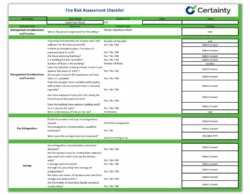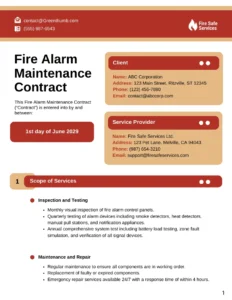Ever been in a real fire drill? The adrenaline, the scramble, the slightly awkward yet urgent shuffling down the stairs? It’s a chaotic but necessary dance. But what happens after everyone makes it to the designated safe zone? That’s where proper documentation comes in. Think of it as the behind-the-scenes paperwork that transforms a potentially messy evacuation into a valuable learning experience. Without it, you’re just repeating the drill without truly improving your preparedness.
A well-structured fire drill documentation template is your best friend when it comes to meticulously recording the ins and outs of each drill. It’s not just about checking off a box to say you did it; it’s about analyzing performance, identifying weaknesses in your emergency procedures, and ultimately, creating a safer environment for everyone involved. It’s a crucial tool for workplace safety and regulatory compliance.
In this article, we’ll explore the importance of comprehensive fire drill documentation, delve into the key elements that should be included in your template, and provide insights on how to use this documentation to continually improve your emergency preparedness. Let’s face it, hoping for the best isn’t a strategy; being prepared is.
Why You Absolutely Need a Fire Drill Documentation Template
Okay, let’s be honest. Documentation isn’t usually anyone’s favorite task. But when it comes to fire drills, it’s an absolute non-negotiable. Think of it as your safety net – a structured record that not only helps you comply with regulations but also serves as a roadmap for improvement. Without a fire drill documentation template, you’re essentially conducting drills in the dark, unable to pinpoint areas that need attention and potentially putting people at risk in the event of a real fire.
The primary reason for using a fire drill documentation template is simple: it provides a standardized way to record essential information about each drill. This includes the date and time of the drill, the number of participants, the time it took to evacuate the building, any problems encountered during the evacuation, and any areas for improvement. Having this information readily available allows you to track your progress over time and identify trends that might otherwise go unnoticed.
Beyond tracking basic data, a good template also encourages you to analyze the effectiveness of your fire safety procedures. Were the evacuation routes clear and unobstructed? Did the fire alarms function correctly? Were employees familiar with the designated meeting point? These are crucial questions to ask after each drill, and the answers should be carefully documented. This information can then be used to make necessary adjustments to your fire safety plan and ensure that everyone is adequately prepared.
Moreover, a fire drill documentation template serves as a valuable training tool. By reviewing past drill reports, you can identify common mistakes or areas where employees need additional training. For instance, if several employees consistently struggle to locate the nearest fire extinguisher, you might consider offering additional training on fire extinguisher use. Similarly, if evacuation times are consistently slow, you might need to re-evaluate your evacuation procedures and identify ways to streamline the process.
Finally, remember that fire drill documentation is often required by law. Regulatory bodies like OSHA (in the US) and similar organizations in other countries may require businesses to conduct regular fire drills and maintain records of those drills. Failure to comply with these regulations can result in fines or other penalties. Therefore, using a fire drill documentation template ensures that you’re meeting your legal obligations and protecting your business from potential liabilities.
Key Elements of an Effective Fire Drill Documentation Template
So, what exactly should be included in your fire drill documentation template to make it truly useful? While the specifics may vary depending on the size and complexity of your organization, there are several key elements that should be included in every template. These elements will help you gather the data you need to analyze your fire safety procedures and identify areas for improvement.
First and foremost, your template should include basic information about the drill, such as the date and time it was conducted, the location of the drill, and the names of the individuals who were responsible for conducting and supervising the drill. This information provides context for the drill and helps you track your progress over time. You’ll also want to record the total number of participants in the drill, as this can affect the evacuation time and provide insights into the effectiveness of your communication efforts.
Next, your template should focus on the evacuation process itself. Record the time it took for the last person to reach the designated assembly point. Note any challenges encountered during the evacuation, such as blocked exits, malfunctioning alarms, or confusion about evacuation routes. These observations are invaluable for identifying areas where your procedures need to be improved.
Another important element of your template is a section for evaluating the effectiveness of your communication methods. Were the alarms clearly audible throughout the building? Did employees understand the instructions given by fire wardens or supervisors? Were there any communication breakdowns that hindered the evacuation process? Addressing these questions can help you refine your communication strategies and ensure that everyone is on the same page during a real emergency.
Finally, your template should include a section for recording any follow-up actions that need to be taken. This might include repairing malfunctioning equipment, updating evacuation plans, providing additional training to employees, or addressing any other issues identified during the drill. Documenting these actions ensures that you’re not just identifying problems but also taking steps to resolve them and improve your overall fire safety preparedness. Using a fire drill documentation template will make the whole process much easier and more effective.
Every business needs to keep on top of its fire safety protocols. Having a robust fire drill documentation template in place helps ensure safety protocols are followed correctly, and any changes required are documented.
Regularly reviewing your fire drill documentation will allow you to quickly spot issues. Make sure to include your entire team in the fire drill to get a good representation of who needs extra help, or if any processes can be improved.



